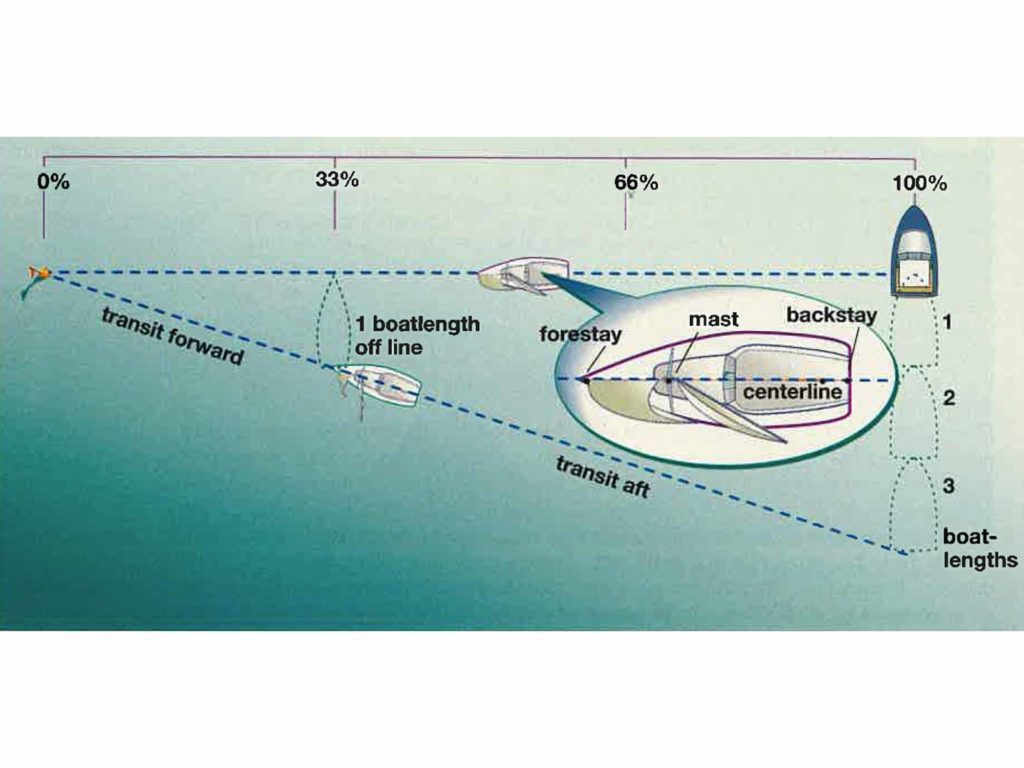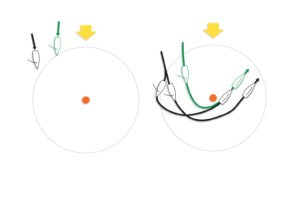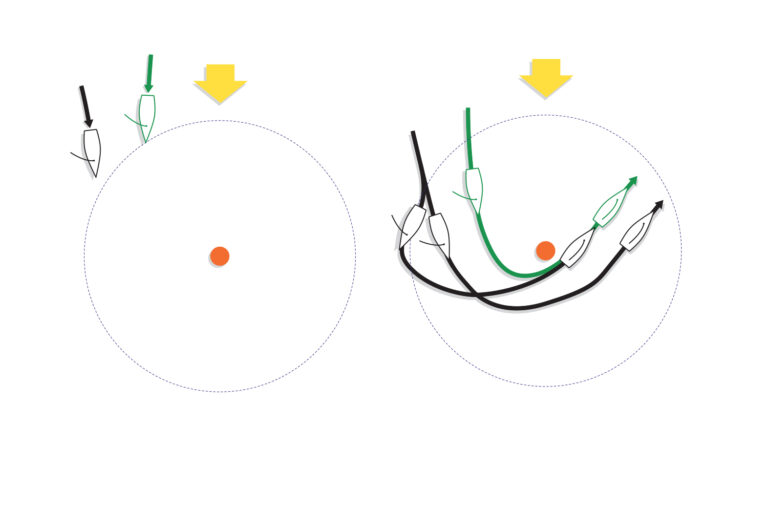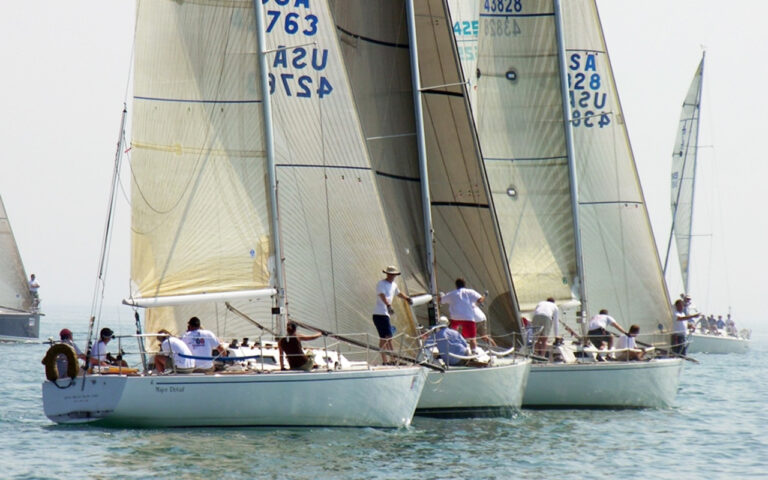
Water, water everywhere, and not a line sight to be had. Have you ever felt that way? If you’ve taken a racing clinic or read a how-to-race book in the past 10 years, you’ve probably been taught the value of getting a line sight. The procedure is as follows: find an object on shore that lines up, more or less, with one end of the starting line when you sight through the opposite end of the line. Then, when you set up for a mid-line start, the line sight gives you a reference to judge your distance from the line.
In the old days, before we were taught the value of line sights, top sailors would simply line their boats up with the nearby competition, and make sure their bow was poked out slightly on the front row when the gun went off. Guaranteed good start.
Then regatta organizers began assigning bow numbers. And race committees became more sophisticated in their methods for catching premature starters. Poking your bow out became very dangerous if you didn’t know exactly where the line was. Hence, the current affection for the line sight.
The problem with line sights, however, is that you need to be close to shore to get one, and the shore has to be littered with items you can sight. What do you do if the racecourse is well offshore, as most big championships are? Here’s where you have to master a new technique: the transit.
How a Transit Works
Sailboats are designed and constructed symmetrically, otherwise they wouldn’t go the same speed on both tacks. The port half of the boat is a mirror image of the starboard half, with the forestay tacked on centerline, the mast stepped on centerline, and the rudder hung on centerline. All three line up, and chances are that other pieces of your boat’s hardware are also mounted on centerline. These centrally located items are used to take a transit.
Let’s imagine you are cruising toward the leeward starting pin, positioned exactly on the starting line. Crouch down in the cockpit, so your line of sight is just on the weather side of the mast and aligned with the forestay. You should be looking straight forward so you can see the precise direction that the boat is traveling. While sighting forward, steer so that the boat is pointed exactly at the leeward end of the starting line.
Next, while still crouching low in the cockpit, turn around and sight aft, over the rudderpost and, say, through the center of the traveler or backstay. Now you are looking precisely aft, on a line that is reciprocal to the course that you are steering. If you’re positioned exactly on the starting line, that aft sight, or transit, will point directly at the reciprocal end of the line: the starting flag on the committee boat. Now you have taken two transits and confirmed you are exactly on the starting line.
Using a Transit Below the Line
It’s easy to use a transit when you are exactly on the line. When approaching from below the line, it’s a bit trickier to know how far off you are. Let’s return to our previous example. You’re reaching toward the leeward end of the line, smack in the center of the starting area. But this time you are below the line, and you need to know by how much.
Just as before, crouch in the cockpit and steer so as to line up the mast, forestay, and leeward pin of the starting line. Then glance astern on the same transit. Let’s say your stern transit points to a spot three boatlengths downwind from the committee boat’s starting flag. Using your high-school geometry, you know that since you are 50-percent of the way down the line, you take half of that threeboatlength distance from the committee boat to find your distance to the line. The answer is one and one-half boatlengths (see illustration).
If you were one-third of the way up the line from the leeward end when you made the transit, you would take 33-percent of the three boatlengths; this puts you one boatlength off the line. If you were two-thirds of the way up the line, closer to the committee boat, you would be two boatlengths off the line.
The accuracy of this measurement depends on correctly estimating how far down the line you are, as well as taking a proper transit sight. With surprisingly little practice, however, you can be accurate to within a boatlength. And with a season of practice, the margin of error can decrease to one-half boatlength.
Tips for Using Transits
Here’s the best way to learn how to do a transit. At a regatta where the race committee will set a long starting line, get out to the starting area early. Ask a fellow competitor to sight the starting line while you sail straight down it. Use your transits to try and stay directly on course. As you concentrate on your position, have your line sighter point to windward when you are over the line, and to leeward when you are behind. This gives you feedback on your transit. This is how America’s Cup bowmen practice calling the line.
When you’re in the final five minutes before the start, sail above the fleet and use your transits to sail directly down the line. When the one-minute rule is in effect, or the fleet is aggressive, be sure to duck down into the fleet with plenty of time to spare. But look over your shoulder, to keep track of where the line is as you head back into the crowd. If you have a mental image of where the line is, it is far easier to sail back up to it in your final approach.
Sometimes, when the fleet is timid or the current is foul, you will have the space to continue reaching down the line, using your transit to stay a boatlength below it. When the gun goes off you simply head up for a front row start. Chances are, the boats you left in your gas will shout that you must be over early. But with your transit, you know better.
It’s not always so easy, however. With an aggressive fleet you will have to sail back down into the lineup with at least two minutes to go. With that much time, it’s easy to lose track of where the starting line is. The solution is to poke your bow back out in front of the lineup with a minute to go, so you can see the leeward end. When you have a visual on the pin, line up your transit and make a quick judgement as to your distance off the line.
You should have a good idea if your “bunch” is going to be behind the line at the start. Then you can decide whether to hang back or pull the trigger early. Like any other weapon in your arsenal, you have to know when to use it.
Ed’s note: Ed Adams—now a fulltime professional coach—was Senior Editor at Large for Sailing World.









